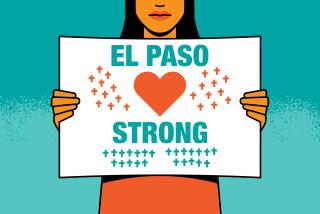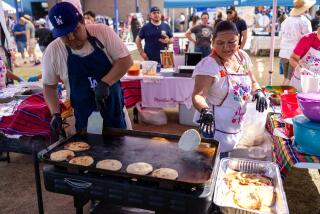Peace March Recalls Tragic 1970 Protest : East L.A.: Parade through the streets commemorates the anti-Vietnam War rally that ended in the deaths of Ruben Salazar and two others.
- Share via
An estimated 5,000 people, many of whom were not born 20 years ago, marched peacefully through East Los Angeles on Saturday to mark the violent anti-Vietnam War protest on the same streets that ended in the death of newsman Ruben Salazar and two others in 1970.
Although the 3 1/2-mile march on Atlantic and Whittier boulevards was staged to bring public attention to the same issues that prompted the original protest rally--U.S. foreign policy and Latinos’ low status in this country--Saturday’s commemoration had a modern beat to it.
For the record:
12:00 a.m. Aug. 27, 1990 For the Record
Los Angeles Times Monday August 27, 1990 Southland Edition Metro Part B Page 6 Column 3 Metro Desk 1 inches; 31 words Type of Material: Correction
Cardenas posters--A caption in the Southland edition of The Times on Sunday misidentified the subject of posters carried by a group of people at a parade. The posters showed Mexican opposition leader Cuauhtemoc Cardenas.
Marchers from throughout the Southwest in outfits ranging from “Save Yosemite” T-shirts to brightly colored aerobics outfits with expensive sneakers shouted and chatted under mostly cloudy skies that gave way to sunshine by early afternoon.
Many of the protesters were college students who said they knew of Salazar’s death and the 1970 protest, considered by many to be the largest political gathering of people of Mexican descent in this country, only from textbooks.
“I’m here because Ruben was murdered by the officers,” said Margaret Alarcon of East Los Angeles College as she and a friend, Gina Aparicio, carried a 10-foot-high portrait of the slain newsman.
Salazar, a Times columnist and news director of Los Angeles television station KMEX, was killed on Aug. 29, 1970, as violence erupted at the end of the march at what was then called Laguna Park. He was sitting in a Whittier Boulevard bar when a tear-gas projectile fired by a sheriff’s deputy struck his head, killing him instantly. The park was later named after the newsman.
Salazar’s death was ruled accidental, but the county paid $700,000 to his widow and three children.
To honor the reporter, a troupe of actors Saturday repeatedly re-enacted the tragic events at the bar as marchers went by. Most of the participants slowed to watch the reenactment of the deputy firing the fatal shot into the lounge.
“Viva Salazar!” was the marchers’ frequent response to the scene.
The exuberance of the young marchers seemed to catch many of the longtime Chicano activists by surprise.
With shouts of “Chicano Power” still ringing in his ears after two hours of marching, Richard Martinez, Los Angeles director of the Texas-based Southwest Voter Registration Education Project, was heard to remark:
“I’ve heard more ‘Chicano Power’ shouts in the last half hour than I have in the last 10 years.”
And if U.S. involvement in Vietnam rankled the National Chicano Moratorium Committee, organizer of the 1970 protest, this march, also staged by the group, gave some participants a chance to criticize the presence of U.S. troops in the Persian Gulf.
“(President) Bush is making the same mistake all over again,” said Denise Ayala, 18, of Rowland Heights. “Iraq is just another way of saying, ‘Vietnam.’ ”
A plethora of causes were espoused by the marchers, many of whom carried Mexican flags.
Placards favoring a Palestinian homeland and political reform in Mexico were mixed with those favoring a sensitive restoration of Olvera Street, a boycott of Tianguis markets and women’s rights to legal abortions.
The marchers also called for better educational and job opportunities and for more affordable housing.
One placard near the start of the procession seemed to capture the heightened ethnic awareness among the college-age marchers. It read: “Yo soy Chicano, not Hispanic.”
One set of observers clearly overjoyed by the march’s festive and peaceful nature was the Los Angeles County Sheriff’s Department.
Eager to avoid a repeat of the violence that prompted 60 injuries and 200 arrests in 1970, deputies kept a low profile as marchers snaked through the streets. No arrests were reported.
“The level of cooperation for this march has been fantastic,” said Sheriff’s Department spokesman Fidel Gonzales.
Some marchers expressed fears about a recurrence of violence, which proved to be unfounded.
Despite a bad leg, Rodolfo Acuna, a Chicano studies professor at Cal State Northridge, marched so he could keep an eye on his wife, Lupe, and daughter, Angela, 5, who were ahead of him in the procession.
“I’d go crazy if something happened to them and I wasn’t here,” he said.
There were, however, some grumblings from Whittier Boulevard merchants and some area residents about the march. Some merchants closed their doors while the marchers went by.
“What are they proving?” asked a merchant, who declined to identify himself. “All they’re doing is bringing back bad memories and the death of Salazar.”
Groused another merchant, who said Saturday was the busiest day for his store: “They should have done this on a Sunday.”
Near the New Silver Dollar bar, where Salazar was killed, resident Rachel Reyes, who was critical of many of the marchers’ opinions, unfurled a black U.S. Navy Seals banner. She said her son, Timothy, recently was sent to the Middle East.
“This is the banner that these people ought to be honoring,” Reyes said.
After the march ended, several speakers urged the crowd at Salazar Park to push for improved educational, social and political rights for Latinos.
“We came to march together and stand up,” said Nita Gonzales, daughter of longtime Chicano activist Rodolfo (Corky) Gonzales of Denver. “Black, brown and red.
“We’re here to add our voices to Chicanos of 20 years ago. We have to let this country know that we will not remain silent. We cannot remain silent.”
Times staff writer George Ramos also contributed to this story.
More to Read
Sign up for Essential California
The most important California stories and recommendations in your inbox every morning.
You may occasionally receive promotional content from the Los Angeles Times.













